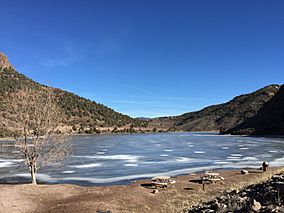Spring Valley State Park facts for kids
Quick facts for kids Spring Valley State Park |
|
|---|---|

Eagle Valley Reservoir in Spring Valley State Park
|
|
| Location | Lincoln County, Nevada, United States |
| Nearest town | Ursine, Nevada |
| Area | 926.83 acres (375.07 ha) |
| Elevation | 5,869 ft (1,789 m) |
| Designation | Nevada state park |
| Established | 1969 |
| Administrator | Nevada Division of State Parks |
| Website | Spring Valley State Park |
Spring Valley State Park is a cool place in eastern Nevada where you can have fun outdoors! It's a special area managed by the state, right next to the 65-acre (26 ha) Eagle Valley Reservoir. This park is close to the border with Utah. You can find it about 20 miles (32 km) east of a town called Pioche, and it's also near the small village of Ursine.
Contents
Discover Spring Valley State Park
Spring Valley State Park is a great spot for adventures. It covers about 927 acres and is located in Lincoln County, Nevada. The park's main feature is the Eagle Valley Reservoir, a large lake perfect for water activities.
Park History: How it Began
The story of Spring Valley State Park starts with the water.
- In 1965, the Eagle Valley Dam was built. This dam created the Eagle Valley Reservoir.
- The reservoir was originally made to help local farms with their water needs.
- Just a few years later, in 1969, the land around this new lake was made into a state park. This means it became a protected area for everyone to enjoy.
Fun Things to Do at the Park
Spring Valley State Park offers lots of activities for visitors.
- Camping: You can set up a tent or park an RV and spend the night under the stars.
- Fishing: The Eagle Valley Reservoir is a popular spot for fishing.
- Boating: There's a boat launch, so you can bring your boat and explore the lake.
- Picnicking: Enjoy a meal outdoors with family and friends at one of the picnic areas.
- Hiking: Explore the park's trails and see the beautiful nature up close.
- Historic Buildings: You can also see old ranch buildings that tell stories of the past.
- Group Areas: There are special spots for larger groups to gather and have fun together.
Weather at Spring Valley State Park
The weather in Spring Valley State Park changes throughout the year.
- Summers (July-August) are warm, with average high temperatures around 85-88°F (29-31°C). The hottest temperature ever recorded was 103°F (39°C).
- Winters (December-February) are cold, with average low temperatures often below freezing, around 8-14°F (-13 to -10°C). The coldest temperature ever recorded was a very chilly -45°F (-43°C)!
- The park gets some rain and snow, especially in winter and early spring. Snowfall is common in the colder months.
| Climate data for Spring Valley SP, NV, 1981-2010 normals, extremes 1974-present | |||||||||||||
|---|---|---|---|---|---|---|---|---|---|---|---|---|---|
| Month | Jan | Feb | Mar | Apr | May | Jun | Jul | Aug | Sep | Oct | Nov | Dec | Year |
| Record high °F (°C) | 64 (18) |
72 (22) |
80 (27) |
84 (29) |
94 (34) |
97 (36) |
103 (39) |
98 (37) |
98 (37) |
89 (32) |
77 (25) |
63 (17) |
103 (39) |
| Mean daily maximum °F (°C) | 43.1 (6.2) |
46.3 (7.9) |
53.7 (12.1) |
61.3 (16.3) |
70.7 (21.5) |
81.9 (27.7) |
88.7 (31.5) |
85.8 (29.9) |
78.6 (25.9) |
66.0 (18.9) |
52.9 (11.6) |
43.6 (6.4) |
64.4 (18.0) |
| Mean daily minimum °F (°C) | 8.6 (−13.0) |
14.3 (−9.8) |
20.1 (−6.6) |
23.7 (−4.6) |
29.8 (−1.2) |
34.8 (1.6) |
42.2 (5.7) |
40.7 (4.8) |
32.0 (0.0) |
22.3 (−5.4) |
14.8 (−9.6) |
7.6 (−13.6) |
24.2 (−4.3) |
| Record low °F (°C) | −29 (−34) |
−33 (−36) |
−10 (−23) |
−3 (−19) |
9 (−13) |
16 (−9) |
24 (−4) |
21 (−6) |
14 (−10) |
2 (−17) |
−20 (−29) |
−45 (−43) |
−45 (−43) |
| Average precipitation inches (mm) | 1.16 (29) |
1.28 (33) |
1.26 (32) |
0.94 (24) |
0.82 (21) |
0.55 (14) |
0.84 (21) |
1.41 (36) |
0.92 (23) |
1.10 (28) |
0.71 (18) |
0.93 (24) |
11.92 (303) |
| Average snowfall inches (cm) | 4.8 (12) |
5.9 (15) |
5.0 (13) |
1.6 (4.1) |
0.2 (0.51) |
0 (0) |
0 (0) |
0 (0) |
0 (0) |
0.4 (1.0) |
2.6 (6.6) |
6.1 (15) |
26.6 (67.21) |
| Average precipitation days | 4 | 6 | 6 | 4 | 4 | 2 | 4 | 4 | 3 | 3 | 3 | 3 | 46 |
| Source: Western Regional Climate Center | |||||||||||||


